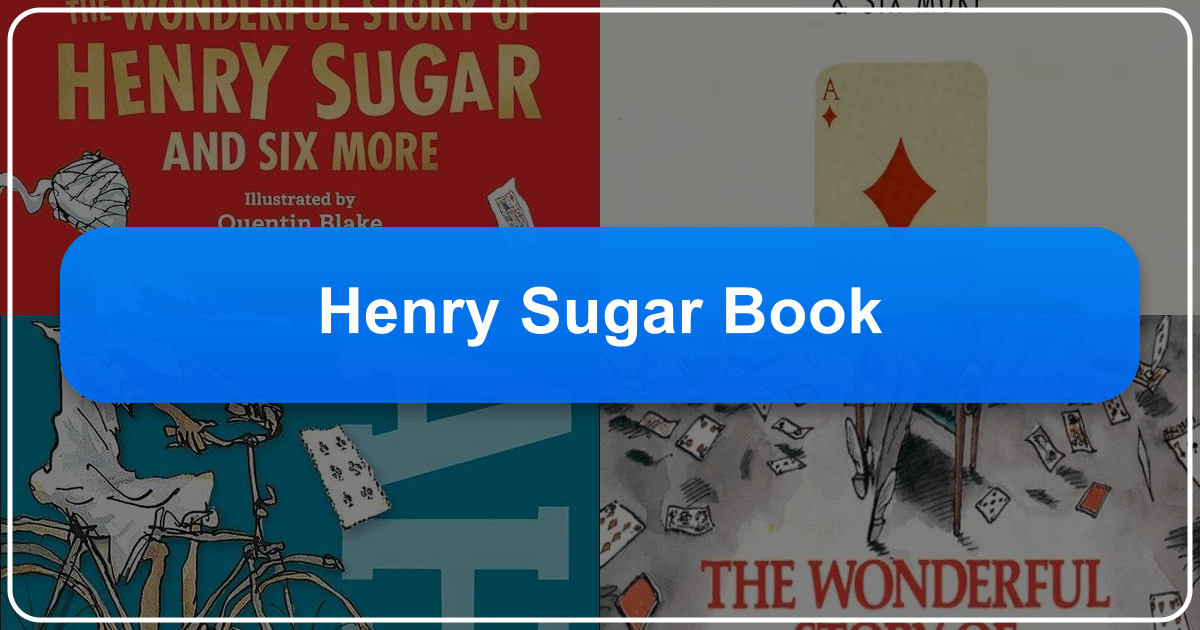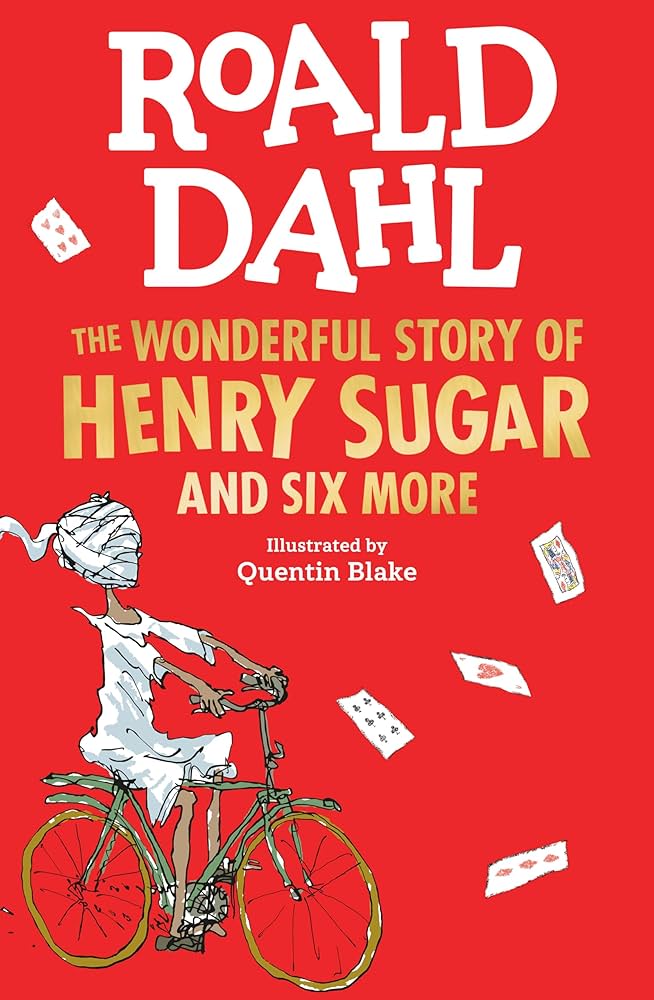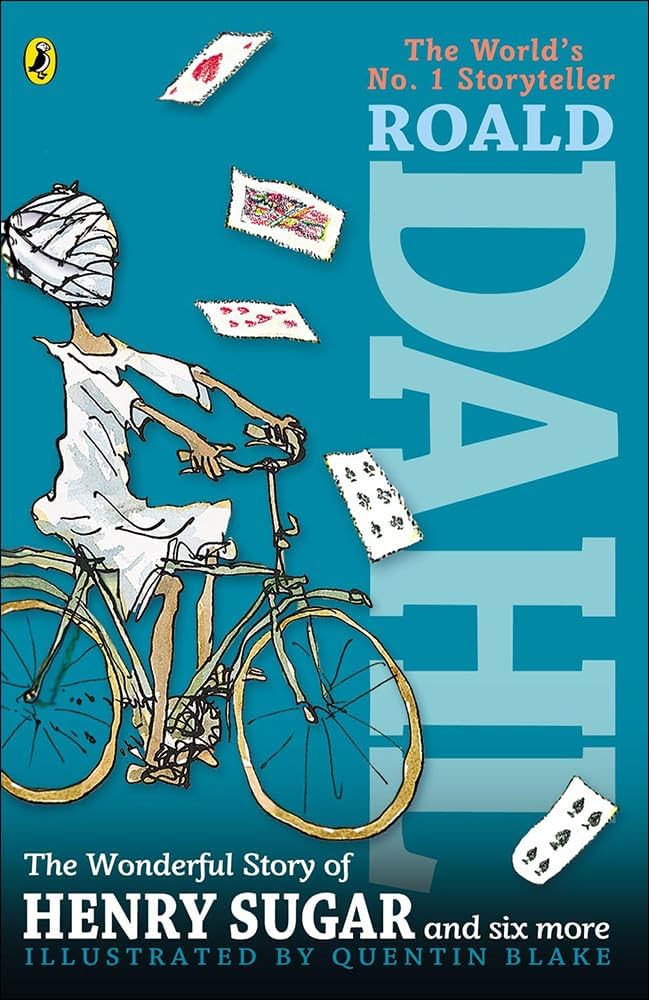The Wonderful Story of Henry Sugar and Six More: A Deep Dive into Roald Dahl's Collection

Roald Dahl’s The Wonderful Story of Henry Sugar and Six More is a captivating collection of seven short stories, each showcasing Dahl’s unique blend of fantasy, reality, and dark humor. Published in 1977, this anthology appeals to a slightly older audience than many of Dahl’s other celebrated children’s books, offering a richer tapestry of themes and narrative styles. This exploration will delve into the book’s content, its author, its impact on readers, and its broader cultural significance across various lenses.

Roald Dahl: Master Storyteller and Authorial Persona
Roald Dahl (1916-1990) needs no introduction to lovers of children’s literature. His name is synonymous with imaginative storytelling, memorable characters, and a subtle yet potent brand of subversive humor. Born in Wales to Norwegian parents, Dahl’s life was filled with adventure, even before he began writing. His experiences working for Shell Oil in Africa, serving as a fighter pilot in World War II, and living in Washington, D.C., all profoundly shaped his unique perspective and informed his stories. These elements are reflected in his writing, which often seamlessly intertwines elements of autobiography and fiction, creating a compelling and uniquely personal experience for the reader.

Dahl’s journey to becoming a writer, as detailed in “Lucky Break,” is itself a fascinating tale. Initially unsure of his writing abilities, he received unexpected encouragement and a publishing opportunity, setting the stage for his long and illustrious career. His keen observation skills, sharp wit, and knack for creating suspense are evident in all his works, including The Wonderful Story of Henry Sugar and Six More. This collection showcases the author’s mastery of several genres, moving effortlessly between whimsical fantasy, realistic portrayals of human nature, and even non-fiction accounts.
Dahl’s Writing Style and Inspirations

Dahl’s writing style is instantly recognizable. His prose is direct, engaging, and often infused with an understated irony that appeals to both children and adults. He masters the art of suspense, building tension gradually before delivering unexpected twists and turns. His characters, while often exaggerated, are richly developed and deeply human in their flaws and motivations. The narratives are typically fast-paced and easy to follow, though they can also surprise readers with their more nuanced and darker themes. He drew inspiration from his own life, global travels, and observations of human behavior. His willingness to explore the darker side of human nature, alongside the lighter moments, sets his stories apart. The book showcases his skill in crafting compelling narratives from various viewpoints, demonstrating his ability to captivate readers of all ages.
Famous Works and Literary Influence
Dahl’s prolific career spanned decades, producing a wealth of beloved stories and novels that continue to resonate with readers. His most famous works include Charlie and the Chocolate Factory, Matilda, The BFG, and James and the Giant Peach. These works have been adapted into hugely successful films and musicals, cementing his legacy in popular culture. His unique style of storytelling—a combination of whimsy, dark humor, and sharp social commentary—has influenced countless other authors and continues to inspire generations of writers and readers. His impact extends beyond pure entertainment, offering insightful glimpses into human nature and challenging societal norms with a deft touch.
The Wonderful Story of Henry Sugar and Six More: A Story-by-Story Exploration
This collection is not simply a grouping of unrelated tales; the stories share thematic threads, exploring concepts of ambition, greed, human nature, and the unexpected consequences of our choices.
The Boy Who Talked with Animals
This enchanting tale follows a young boy with the remarkable ability to communicate with animals. The story is narrated in the first person, immersing the reader in the boy’s world and the magical interactions he has with the creatures around him. The story highlights the cruelty and selfishness of adults juxtaposed with the child’s innate compassion for animals and nature. The unexpected ending adds a layer of mystery, leaving the reader to ponder the boy’s fate and the power of connection with the natural world.
The Hitch-Hiker
This first-person narrative introduces a seemingly ordinary encounter that spirals into a darkly comedic exploration of deception and human nature. The “fingersmith,” a master pickpocket, showcases his incredible dexterity, demonstrating the surprising skills individuals can possess. This story is a suspenseful adventure that exposes the flaws and consequences of greed and the unpredictable nature of human interaction.
The Mildenhall Treasure
This non-fiction piece deviates from the fictional narratives but retains Dahl’s signature storytelling prowess. The real-life discovery of the Mildenhall Treasure serves as a captivating anecdote highlighting dishonesty and the triumph of historical discovery over personal gain. It illustrates how ordinary individuals can stumble upon extraordinary events, challenging the reader’s perceptions about fortune and opportunity.
The Swan
This short story depicts the disturbing consequences of unchecked cruelty and bullying, exploring themes of revenge and justice. The protagonist, Peter Watson, a shy boy, finds himself at the mercy of a cruel bully. The story ends unexpectedly and leaves the reader reflecting on the lasting impact of violence and bullying. The symbolic imagery creates a powerful metaphor about the consequences of cruelty.
The Wonderful Story of Henry Sugar
This is the title story and the heart of the collection. Henry Sugar, a wealthy gambler, discovers the secret to seeing without using his eyes and leverages this ability for personal gain in casinos around the world. However, Dahl weaves a moral tale here; his newfound power initially leads to dissatisfaction and a desire to use his skills for greater good. The story’s unexpected conclusion highlights the lasting impact of one’s choices and suggests that true fulfillment comes not from material wealth but from acts of generosity and kindness. This story alone demonstrates Dahl’s ability to seamlessly incorporate elements of fantasy, humor, and thought-provoking social commentary.
Lucky Break
This autobiographical piece provides insightful context to the author’s life and sheds light on his journey to becoming a successful writer. It’s a concise yet captivating account of significant events in Dahl’s life, showcasing his talent for storytelling while offering a glimpse into his personal struggles and triumphs. This piece adds another layer of intrigue to understanding the author’s perspective and creative vision.
A Piece of Cake
Another autobiographical piece, this story delves into Dahl’s experiences as a fighter pilot during World War II. It narrates a suspenseful incident from his military career, effectively demonstrating the stark realities of war and adding a personal touch to the collection’s thematic explorations of human nature and resilience.
Cultural Impact and Adaptations
The Wonderful Story of Henry Sugar and Six More has left a lasting mark on readers and popular culture. The enduring appeal of Dahl’s storytelling is evident in the continued popularity of his books, and their frequent adaptations into film, television, and theater. The publication of this particular book collection showcases the author’s versatile style, ranging from dark humor to poignant reflections on human behavior, solidifying his presence in literature for both children and adults.
Wes Anderson’s Film Adaptations
In a remarkable turn of events, Wes Anderson directed a film adaptation of the titular story, The Wonderful Story of Henry Sugar, starring Benedict Cumberbatch, Ralph Fiennes, Dev Patel, Ben Kingsley, and Richard Ayoade. This adaptation, released by Netflix, reflects Anderson’s distinctive visual style and pays homage to Dahl’s unique narrative approach. The success of this adaptation further underscores Dahl’s enduring influence on popular culture. Additionally, Anderson subsequently adapted “The Swan” into a short film, showcasing the collection’s diverse thematic elements to a broader audience.
Awards and Critical Reception
Dahl’s works have received widespread critical acclaim, and The Wonderful Story of Henry Sugar and Six More has undoubtedly contributed to his lasting reputation. The book has received positive reviews for its engaging storytelling, memorable characters, and subtle social commentary. The Wes Anderson adaptation of The Wonderful Story of Henry Sugar has received critical recognition and garnered additional attention to the collection. The film’s success further cemented Dahl’s enduring popularity.
Reading Habits and Educational Value
Roald Dahl’s stories, including those in this collection, foster a love of reading in young audiences. His engaging narrative style and relatable (albeit often eccentric) characters encourage further reading and exploration of literature. Beyond the sheer entertainment, Dahl’s stories offer valuable life lessons, subtly exploring themes of morality, empathy, and resilience. Teachers and parents can use his works to spark discussions about complex topics and encourage critical thinking. The anthology’s diversity in narrative structure and themes broadens the scope for educational engagement.
Communities and Literary Influence
Dahl’s work has built strong communities of fans across generations. Online forums and social media platforms are filled with discussions, interpretations, and shared experiences related to his stories. The impact of his work on later writers, illustrators, and filmmakers is undeniable, demonstrating his significant and enduring influence on the literary landscape. The collection’s recent film adaptations have generated renewed interest in Dahl’s work, inspiring new discussions and interpretations.
In conclusion, The Wonderful Story of Henry Sugar and Six More is more than just a collection of short stories; it’s a testament to Roald Dahl’s exceptional storytelling abilities and his lasting influence on literature and popular culture. Its enduring appeal lies in its masterful blend of fantasy and reality, its exploration of complex themes, and its ability to captivate readers of all ages. The book’s recent film adaptations only reinforce its significance and continue to expand its reach to new audiences worldwide.